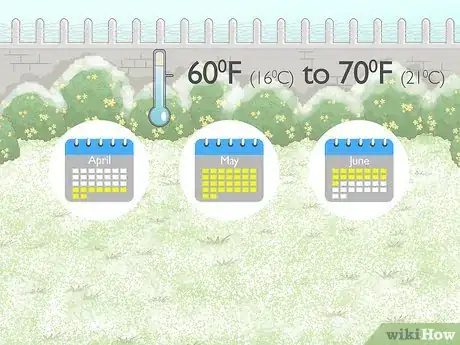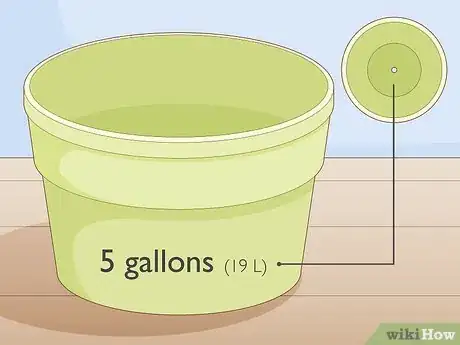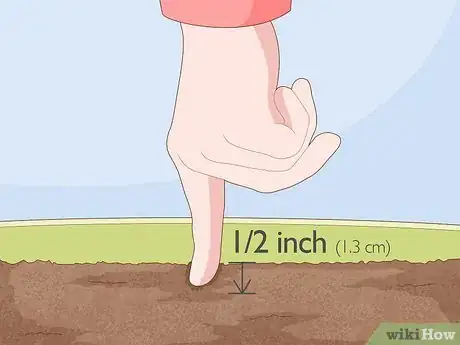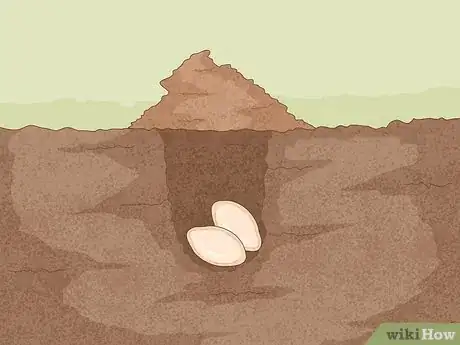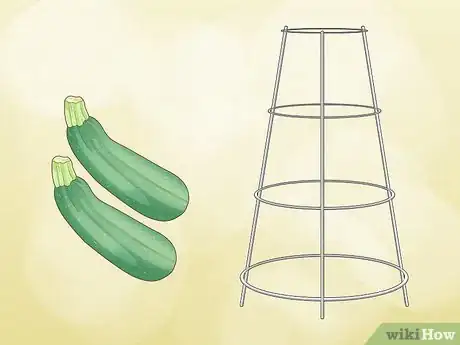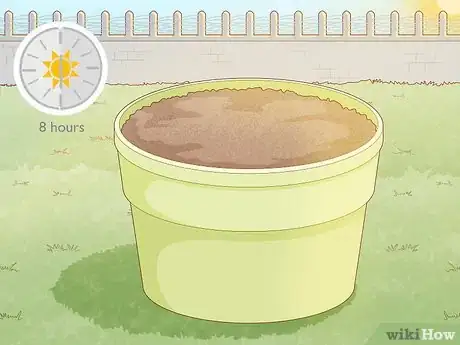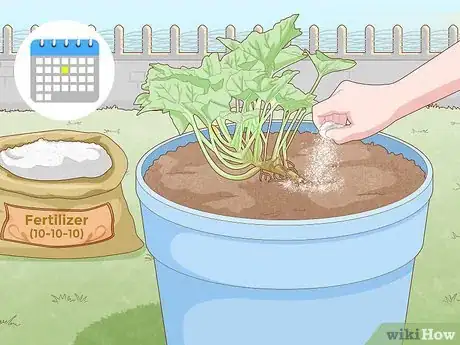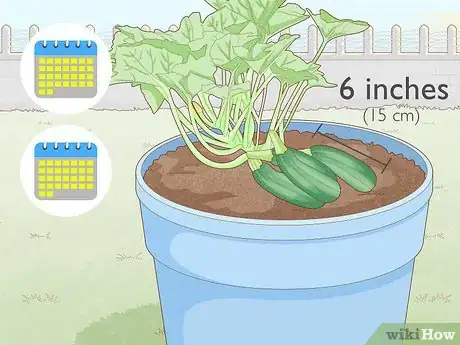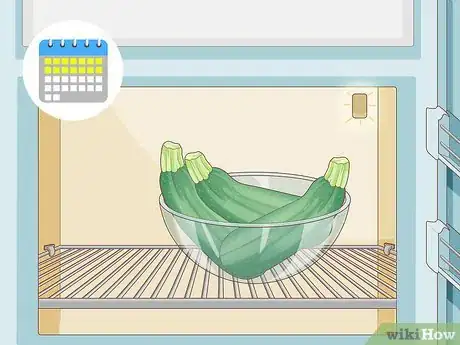This article was co-authored by wikiHow staff writer, Hannah Madden. Hannah Madden is a writer, editor, and artist currently living in Portland, Oregon. In 2018, she graduated from Portland State University with a B.S. in Environmental Studies. Hannah enjoys writing articles about conservation, sustainability, and eco-friendly products. When she isn’t writing, you can find Hannah working on hand embroidery projects and listening to music.
There are 11 references cited in this article, which can be found at the bottom of the page.
This article has been viewed 22,799 times.
Learn more...
Zucchini is a delicious and nutritious vegetable that can be used in many recipes or even eaten on its own. If you’d like to grow some zucchini, you might think you need a large garden or yard area to plant your seeds. However, you can absolutely plant zucchini in a pot and reap the rewards. Simply buy a 5 gallon pot to plant in, keep your zucchini in a sunny spot, and water your plant daily to grow zucchinis on your own.
Steps
Planting Your Zucchini
-
1Plant your zucchini after the last frost of the year. Depending on where you live, you may plant your zucchini between late April and mid-June. Make sure that you plant your zucchini when there is no chance of the temperature going below freezing, since these cold temperatures will likely kill your zucchini.[1]
- If you have a greenhouse, you can plant your zucchini at any time.
- 60 °F (16 °C) to 70 °F (21 °C) is the optimal temperature range to plant zucchini.
-
2Buy a pot with drainage holes that holds 5 gallons (19 L). Zucchini have large tap roots that will reach far down into the soil. Purchase a pot that can hold at least 5 gallons (19 L) of soil in it that has holes in the bottom area for water to drain out. These pots will be large, so make sure you have a space to keep your 5 gallons (19 L) pot, like a porch or backyard area.[2]
Tip: You can use a peat pot for a biodegradable container option.
Advertisement -
3Fill the pot with soil up to 1 inch (2.5 cm) from the top. Use soil that has ingredients like peat moss, perlite, and compost. Pour enough soil into your pot so that only 1 inch (2.5 cm) at the top is left free. Lightly pack down your soil so that it is not loose, but not so tight that the zucchini roots won’t be able to move through it.[3]
- You can purchase soil at your local garden or hardware store.
- Wear gardening gloves when touching your soil.
-
4Make a hole 1⁄2 inch (1.3 cm) deep in the soil with your finger. Use your pointer finger to dig out a hole in the soil in the very center of the pot. Make the hole at least 1 inch (2.5 cm) wide so that your seeds will fit in it. Use gardening gloves when digging in your soil.[4]
-
5Plant 2 seeds in the hole and cover with 1⁄2 inch (1.3 cm) of soil. 1 seed that you plant might not make it to fruition. Plant 2 seeds to ensure that you get at least 1 zucchini plant to grow. Place the seeds about 1⁄2 inch (1.3 cm) down inside of the soil and cover them up. Do not press down on the soil on top of them or around them.[5]
- You can use zucchini starts instead of seeds if you think your seeds might die off before they sprout. Buy some from your local garden store.
-
6Add a stake or tomato cage if your zucchini type needs it. Some zucchini varieties, like Black Forest, are climbing zucchini, meaning that their vines will reach upward as they grow. Check on your seed packet or your starts label to determine if your zucchini are a climbing type. If they are, put a 4 feet (1.2 m) wooden stake or tomato cage next to the seeds or starts you just planted.[6]
- If your zucchini are already growing when you realize they are climbing, you can put a stake next to them to encourage the vines to climb upward.
-
7Put your pot in an area with at least 8 hours of sun a day. Zucchini thrives on heat and getting sunlight. Make sure your pot is in an area that gets at least 8 hours of sunlight per day. South-facing windows or balconies get the most sun daily.[7]
- Make sure your pot won’t get knocked over by curious pets or critters by putting it on the ground instead of on a window sill or shelf.
Taking Care of Your Zucchini
-
1Water your zucchini plant daily. The soil your zucchini is in should be moist at all times. Water your zucchini pot at least once per day. Point your water source at the base of the plant and try to avoid getting water on the leaves. If the leaves get wet, they could get diseased or moldy. If the summer is particularly dry and hot, you may need to water twice a day. Feel the soil to make sure it hasn’t dried out.[8]
Tip: Keep a hose or watering can nearby to make watering easier.
-
2Fertilize your zucchini every month. Add a balanced 10-10-10 fertilizer to your zucchini pot once a month to keep nutrients flowing into the soil. Apply a thin layer of fertilizer to the top of your soil and spread it around evenly. Do not cover up any starts or shoots that may be growing.[9]
- You can buy fertilizer at your local garden or hardware store.
- 10-10-10 fertilizer has equal parts nitrogen, phosphorus, and potassium.
- Adding broken down compost to your zucchini soil instead of fertilizer can also help feed it.
-
3Spray peppermint spray on your zucchini leaves to deter pests. Aphids, vine boring beetles, and spider mites are common pests that love to eat zucchini. To avoid these pests damaging your plant, mix together 1 gallon (3.8 L) of water, 1 teaspoon (4.9 mL) of peppermint oil, and a drop of dish soap. Spray the peppermint mixture on your zucchini leaves when they are damp once a day.[10]
- The best time to spray your peppermint spray is in the evening when it is cool. That way, it won’t evaporate as quickly.
- The smell of peppermint deters pests and can even kill some soft-bodied insects.
-
4Cut back the smaller seedling when your seeds reach 8 inches (20 cm) tall. Your pot will only be able to support 1 zucchini. When 1 of your seedlings reaches about 8 inches (20 cm) tall, snip the smaller one back with scissors to stop it from growing. This lets the nutrients of the soil be diverted to only 1 zucchini plant.[11]
- Always use scissors to cut your seedling. Never rip or tear them, or you could damage your plant.
Harvesting Zucchini
-
1Pick your zucchini when it is 6 inches (15 cm) long. This usually takes 45 to 60 days of growth. Your plant will continue to sprout zucchini until the cold season hits again and the plant dies off. If you leave your zucchini for too long on the vine, they could start to rot.[12]
-
2Cut your zucchini at the base of the plant with scissors. Make sure your scissors are sharp. Do not bend or twist the zucchini to get it off of the vine, or you could damage the plant. Grab the fruit gently and hold it as you cut so that it doesn’t fall. Wear gardening gloves to protect your hands, since zucchini vines are prickly.[13]
- You can also carefully use a sharp knife instead of scissors.
- Make sure your scissors are clean by running them under water and scrubbing them with soap before you cut your zucchini.
-
3Store your unwrapped zucchini in the fridge for 1 to 2 weeks. Your zucchini will stay fresh for a few weeks after you pick it. Put it in the crisper of your fridge and leave it uncovered. If you are worried about getting food or grime on your zucchini, put it in a paper bag and leave the top open. This encourages airflow while protecting your zucchini.[14]
- Use your zucchini to make zucchini bread, make zucchini noodles, or even freeze it to save it for later.
Things You’ll Need
- 5 gallon pot
- Soil
- 10-10-10- fertilizer
- Zucchini seeds or starts
- Scissors or knife
- Stake or tomato cage (optional)
- Peppermint oil
- Dish soap
References
- ↑ https://www.youtube.com/watch?v=7gg8BrCADls&feature=youtu.be&t=14
- ↑ https://harvesttotable.com/zucchini-growing-quick-tips/
- ↑ https://www.youtube.com/watch?v=TWIoXTm9u0o&feature=youtu.be&t=69
- ↑ https://www.youtube.com/watch?v=AydevOJIVHk&feature=youtu.be&t=114
- ↑ https://www.youtube.com/watch?v=7gg8BrCADls&feature=youtu.be&t=60
- ↑ http://www.mysquarefootgarden.net/pruning-zucchini/
- ↑ https://harvesttotable.com/zucchini-growing-quick-tips/
- ↑ https://www.backyard-vegetable-gardening.com/watering-zucchini.html
- ↑ https://www.backyard-vegetable-gardening.com/watering-zucchini.html
- ↑ https://www.youtube.com/watch?v=P1SjjTFRJhg&feature=youtu.be&t=80
- ↑ https://www.youtube.com/watch?v=7gg8BrCADls&feature=youtu.be&t=60
- ↑ https://www.veggiegardener.com/threads/how-and-when-to-pick-zucchini.1725/
- ↑ https://www.youtube.com/watch?v=MtXwdgIdBHY&feature=youtu.be&t=39
- ↑ https://www.epicurious.com/expert-advice/how-to-store-zucchini-and-summer-squash-and-freeze-for-long-term-storage-article
